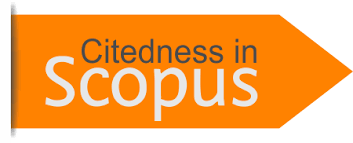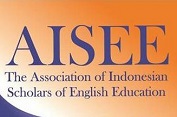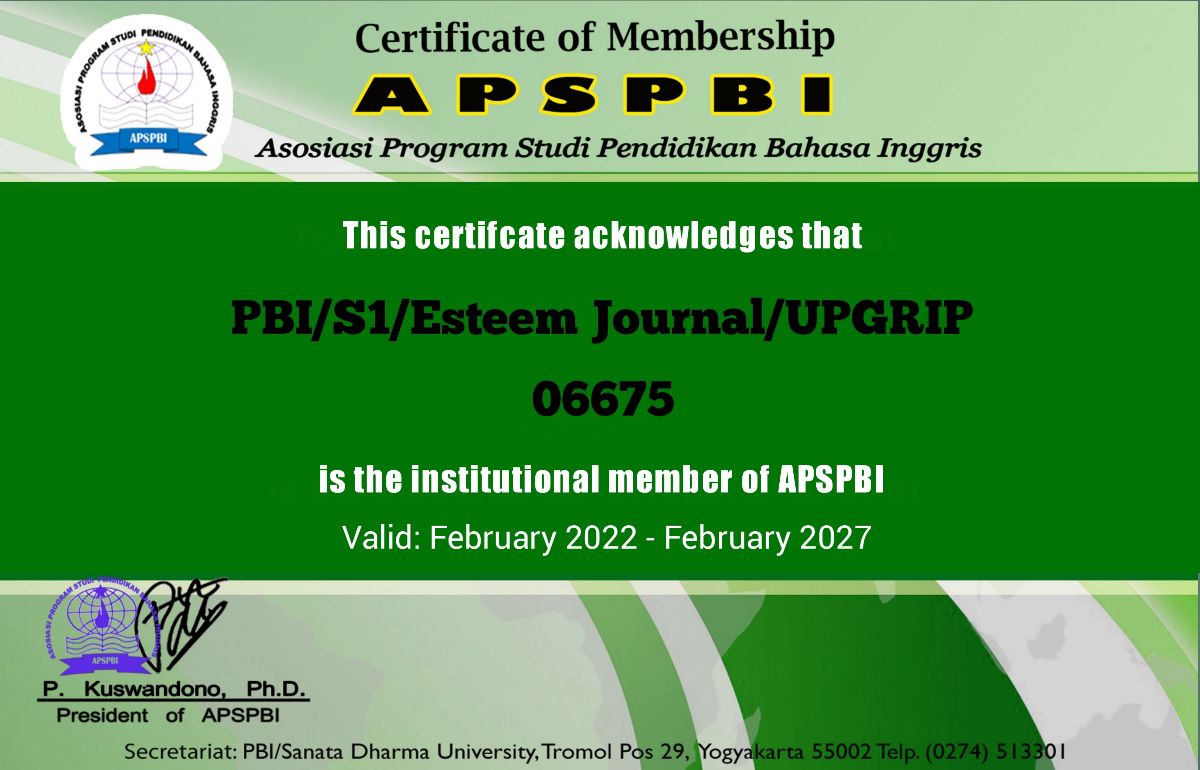ENHANCING STUDENTS SPEAKING SKILL THROUGH ACTING PLAY SCRIPTS (APS) TECHNIQUE
DOI:
https://doi.org/10.31851/esteem.v6i2.12313Keywords:
Acting Play Script (APS) Technique, Speaking , Speaking SkillAbstract
During the process of learning to speak, students often encounter various challenges. Many students exhibit passivity in speaking lessons and lack confidence when speaking in front of the class due to limited vocabulary and a lack of conceptual understanding. The researcher aimed to determine whether the use of "Acting Play Scripts" (APS) in teaching speaking could improve students' speaking skills. The research problem focused on the effectiveness of teaching speaking through the APS technique for students in the English Department of PGRI University Palembang. The objective was to assess the effectiveness of the APS technique in enhancing students' speaking abilities. The study specifically concentrated on students' speaking proficiency in English and utilized a pre-experimental method with a one-group pre-test and post-test design. The researcher selected a single class, namely the 5A class of fifth-semester students from the English Department, comprising 33 students. The findings revealed that the average score in the pre-test was 63.80, while the average score in the post-test was 71.51. The significance level was set at 5%, with a degree of freedom (df) of 32. The critical value of the t-table was 1.6938, and the t-obtained was 55.07. Therefore, the null hypothesis (Ho) was rejected and the alternative hypothesis (Ha) was accepted, indicating that teaching speaking through the APS technique was effective for students in the English Department of PGRI University Palembang. The APS technique resulted in improvements in students' speaking abilities, including their mean scores, their ability to express ideas using appropriate vocabulary and grammar, and their pronunciation development. The implementation of the APS technique in the speaking classroom exhibited strengths, such as increased student participation and enhanced speaking skills.
References
Arikunto, Suharsimi. (2013). Prosedure penelitian. Reneka Cipta.
Burns, A., & Joyce, H. (1997). Focus on Speaking. National Center for English Language Teaching and Research.
Fattah, T. S. A. E. L. (2006). The Effective of a Task-Based Instruction Programin Developing English Speaking skill of Secondary Stage Students. Ain Shams University.
Fraenkel,et.al. (2012). How to Design And Evaluate Research In Education. Mcgraw-hill,inc.
Harmer, J. (1998). The Practice of EnglishLanguage Teaching. Longman inc.
Harmer, J. (2001). The Practice of English Language Teaching (3rd Ed.). Longman Group. [Google – Online]. Available at https://www.abebooks.com/9780582403857/Practice-English-Language-Teaching-3rd-0582403855/plp. [Desember 4, 2022]
Harmer, J. (2005). The Practice of English Language Teaching (4th Ed.). Longman Group. [Google – Online]. Available at https://coljour.files.wordpress.com/2018/09/jeremy_harmer_the_practice_of_english_language_teaching_4th_edition_longman_handbooks_for_language_teachers.pdf. [September 2, 2022]
Harmer, J. (2007). How to Teach English. Cambridge University Press.
Hatch, E., & Farhady, H. (1982). Research Design and Statistics for Applied Linguistics. Newbury House Publishers, Inc.
Herliani, N. (2013). The Use of Guessing Game To Improve Student’s Speaking Skill. Unpublished Reserch Proposal. Faculty of Language and Art Education University Indonesia of Education.
Hornby, A.S (1995). Oxpord Advanced Learner’s Dictionary of Currant English. University press.
Hosni, S. Al. (2014). “Speaking Difficuilities Encounter By Young EFL Learner”. IJSELL.Vol 2:22-30.
Jaya, A., Hermansyah., & Rosmiyati, E. (2019). Redefining Project Based Learning in English Class. ESTEEM: Journal of English Education Study Programme, 2(2), 121-128.
Jaya, A., Mardhiyah, A., & Uzer, Y. (2023). Students' Speaking Ability Through Small group Discussion. ESTEEM: Journal of English Education Study Programme, 6(1), 81-86.
Jaya, A., Mortini, A. V., & Zam, M. A. A. (2023). The Effect of Map Libs Technique on Students’ English Learning Achievement in Learning Personal Pronoun. ESTEEM: Journal of English Education Study Programme, 6(2), 216-225.
Richards, J. C. (2009). Article Teaching Listening and Speaking: From Theory to Practice. Cambridge University Press. [Google – Online]. Available athttps://www.researchgate.net/publication/255634567_Teaching_Listening_and_Speaking_From_Theory_to_Practice [September 1, 2022] [Google-Online]. Available at http://www.lwbooks.co.kr/dn/play_script.pdf [September 1, 2022]
Richards, J. C. & Richard, S. (2002). Dictionary of Language Teaching And Applied Linguistic. Pearson Educational Limited.
Sagala, S. (2008). Konsep dan Makna Pembelajaran untuk Memecahkan Problematika Belajar dan Mengajar. Alfabeta.
Scrivener, J. (1994). Learning Teaching: A guidebook for English Language Teachers. Macmillan – Heinemann. English Language Teaching (ELT)- Oxford. A division of Macmillan Publishers Limited.
Scrivener, J. (2005). Learning teaching: A guide for English language teachers. (2nd ed.). MacMillan
Sugiyono. (2010). Statistika Untuk Penelitian. Alfabeta.
Sugiyono. (2014). Metode Penelitian Pendidikan. Alfabeta.
Wilson, S. M., Peterson, & Penelope, L. (2006). Theories of Learning and Teaching What Do They Mean for Educators?. National Education Association.
Yuliati, E. (2010). Implementing An Acting Play Scripts Technique To Improve Students’ Speaking Skill (A Classroom Action Research at SMPN IKalitidu): A Thesis. Graduate Degree in English Education, Universitas Sebelas Maret, Surakarta. [Google–Online]. Available at https://core.ac.uk/download/pdf/16506952.pdf [September 1, 2022]
Downloads
Published
Issue
Section
License
Copyright (c) 2023 Herlina Herlina, Marleni Marleni, Mega Prasrihamni

This work is licensed under a Creative Commons Attribution-NonCommercial-ShareAlike 4.0 International License.
Copyright Notice
Authors who publish with this journal agree to the following terms:
In order to assure the highest standards for published articles, a peer review policy is applied. In pursue of the compliance with academic standards, all parties involved in the publishing process (the authors, the editors and the editorial board and the reviewers) agree to meet the responsibilities stated below in accordance to the Journal publication ethics and malpractice statement.
Duties of Authors:
- The author(s) warrant that the submitted article is an original work, which has not been previously published, and that they have obtained an agreement from any co-author(s) prior to the manuscript’s submission;
- The author(s) should not submit articles describing essentially the same research to more than one journal;
- The authors(s) make certain that the manuscript meets the terms of the Manuscript Submission Guideline regarding appropriate academic citation and that no copyright infringement occurs;
- The authors(s) should inform the editors about any conflict of interests and report any errors they subsequently, discover in their manuscript.
Duties of Editors and the Editorial Board:
- The editors, together with the editorial board, are responsible for deciding upon the publication or rejection of the submitted manuscripts based only on their originality, significance, and relevance to the domains of the journal;
- The editors evaluate the manuscripts compliance with academic criteria, the domains of the journal and the guidelines;
- The editors must at all times respect the confidentiality of any information pertaining to the submitted manuscripts;
- The editors assign the review of each manuscript to two reviewers chosen according to their domains of expertise. The editors must take into account any conflict of interest reported by the authors and the reviewers.
- The editors must ensure that the comments and recommendations of the reviewers are sent to the author(s) in due time and that the manuscripts are returned to the editors, who take the final decision to publish them or not.
Authors are permitted and encouraged to post online a pre-publication manuscript (but not the Publisher final formatted PDF version of the Work) in institutional repositories or on their Websites prior to and during the submission process, as it can lead to productive exchanges, as well as earlier and greater citation of published work (see The Effect of Open Access). Any such posting made before acceptance and publication of the Work shall be updated upon publication to include a reference to the Publisher-assigned DOI (Digital Object Identifier) and a link to the online abstract for the final published Work in the Journal.





























